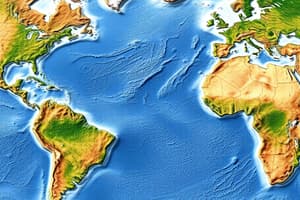Podcast
Questions and Answers
What geological process forms new rock at the mid-ocean ridges?
What geological process forms new rock at the mid-ocean ridges?
- Magma eruption
- Seafloor trenching
- Seafloor spreading (correct)
- Subduction
Why are the oldest seafloor rocks only about 180 million years old?
Why are the oldest seafloor rocks only about 180 million years old?
- They are recycled into the mantle.
- They are continuously created at the surface.
- They descend into trenches and are removed. (correct)
- They can be found at oceanic islands.
What type of rock forms when magma rises and cools at the seafloor?
What type of rock forms when magma rises and cools at the seafloor?
- Metamorphic rock
- Igneous rock (correct)
- Sedimentary rock
- Sedimentary strata
What happens at locations where the plates of the Earth's crust move apart?
What happens at locations where the plates of the Earth's crust move apart?
Which of the following statements is true about continental rocks compared to seafloor rocks?
Which of the following statements is true about continental rocks compared to seafloor rocks?
Flashcards
Seafloor Spreading
Seafloor Spreading
The process where new seafloor is created at mid-ocean ridges, as magma rises, cools, and solidifies, pushing existing seafloor away from the ridge.
Mid-Ocean Ridges
Mid-Ocean Ridges
Locations on the ocean floor where magma rises from Earth's interior, cools, and solidifies, forming new seafloor.
Magma
Magma
Molten rock found beneath Earth's surface.
Trenches
Trenches
Signup and view all the flashcards
Age of Seafloor Rocks
Age of Seafloor Rocks
Signup and view all the flashcards
Study Notes
Seafloor Spreading
- Scientists discovered age and magnetic patterns in the seafloor about 40 years ago.
- This helped understand plate tectonics better.
- New seafloor forms continuously at mid-ocean ridges.
- Magma rises from Earth's interior, cools, and solidifies into new rock.
- Seafloor spreading occurs where plates move apart at ridges.
- Plates move away from the ridge, causing the seafloor to spread slowly.
- Trenches form where one plate slides under another.
- Older seafloor descends into trenches, meaning the oldest is around 180 million years old.
- Continental rocks are much older, some dating back 4 billion years.
Studying That Suits You
Use AI to generate personalized quizzes and flashcards to suit your learning preferences.




